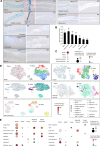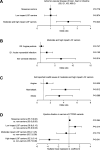PTPRG is an ischemia risk locus essential for HCO3--dependent regulation of endothelial function and tissue perfusion
- PMID: 32955439
- PMCID: PMC7541084
- DOI: 10.7554/eLife.57553
PTPRG is an ischemia risk locus essential for HCO3--dependent regulation of endothelial function and tissue perfusion
Abstract
Acid-base conditions modify artery tone and tissue perfusion but the involved vascular-sensing mechanisms and disease consequences remain unclear. We experimentally investigated transgenic mice and performed genetic studies in a UK-based human cohort. We show that endothelial cells express the putative HCO3--sensor receptor-type tyrosine-protein phosphatase RPTPγ, which enhances endothelial intracellular Ca2+-responses in resistance arteries and facilitates endothelium-dependent vasorelaxation only when CO2/HCO3- is present. Consistent with waning RPTPγ-dependent vasorelaxation at low [HCO3-], RPTPγ limits increases in cerebral perfusion during neuronal activity and augments decreases in cerebral perfusion during hyperventilation. RPTPγ does not influence resting blood pressure but amplifies hyperventilation-induced blood pressure elevations. Loss-of-function variants in PTPRG, encoding RPTPγ, are associated with increased risk of cerebral infarction, heart attack, and reduced cardiac ejection fraction. We conclude that PTPRG is an ischemia susceptibility locus; and RPTPγ-dependent sensing of HCO3- adjusts endothelium-mediated vasorelaxation, microvascular perfusion, and blood pressure during acid-base disturbances and altered tissue metabolism.
Keywords: acidosis; bicarbonate; cerebral blood flow and metabolism; endothelium-dependent vasorelaxation; genetics; genomics; human; ischemia; medicine; metabolic regulation; mouse.
Plain language summary
Restricted blood flow in the heart or brain can deprive these vital organs of oxygen, thereby causing a heart attack or stroke. However, the body has compensatory mechanisms to mitigate damage: if the blood flow is reduced in one blood vessel, acidic waste accumulates locally. This causes nearby blood vessels to widen and increase the oxygen supply. Although scientists first observed this process 140 years ago, they have not yet devised a way to use it for treatment of heart attack or stroke. Now, Hansen et al. discovered that a protein called RPTPγ, which is found on the lining of blood vessels, could be a good target for drugs intended to reduce the consequences of heart attacks and strokes. The protein RPTPγ has a similar structure to other proteins that bind bicarbonate, an important ion that buffers acids in the body. RPTPγ can also trigger signals to nearby cells, which suggests that the protein can monitor bicarbonate levels in the blood and tissue and alert blood vessels of the need to widen. Hansen et al. found that the blood vessels of mice that lacked RPTPγ were unable to widen when needed. Moreover, mice without RPTPγ experienced abnormal changes in blood pressure and blood flow to the brain when oxygen consumption was elevated or pH was disrupted. Hansen et al. further analyzed genetic and health data from nearly 50,000 individuals in the UK Biobank. These analyses revealed that people with genetic changes that render RPTPγ ineffective are at higher risk of having a heart attack or stroke. People with these genetic variants also have reduced heart pumping ability. The experiments suggest that a lack of functional RPTPγ affects an individual’s ability to adjust local blood flow in response to acid-base disturbances and oxygen deficits, increasing the risk of a heart attack or stroke. This information may help scientists develop new ways to prevent or treat heart attacks and strokes, or to treat other conditions like cancer, where pH is disturbed.
© 2020, Hansen et al.
Conflict of interest statement
KH, CS, PR, CH, SK, MN, VM, EB No competing interests declared
Figures







Similar articles
-
Extracellular HCO3- is sensed by mouse cerebral arteries: Regulation of tone by receptor protein tyrosine phosphatase γ.J Cereb Blood Flow Metab. 2016 May;36(5):965-80. doi: 10.1177/0271678X15610787. Epub 2015 Oct 19. J Cereb Blood Flow Metab. 2016. PMID: 26661205 Free PMC article.
-
Role of Receptor Protein Tyrosine Phosphatase γ in Sensing Extracellular CO2 and HCO3.J Am Soc Nephrol. 2016 Sep;27(9):2616-21. doi: 10.1681/ASN.2015040439. Epub 2016 Feb 2. J Am Soc Nephrol. 2016. PMID: 26839367 Free PMC article.
-
Characterization of PTPRG in knockdown and phosphatase-inactive mutant mice and substrate trapping analysis of PTPRG in mammalian cells.PLoS One. 2012;7(9):e45500. doi: 10.1371/journal.pone.0045500. Epub 2012 Sep 20. PLoS One. 2012. PMID: 23029056 Free PMC article.
-
Regulation of coronary blood flow during exercise.Physiol Rev. 2008 Jul;88(3):1009-86. doi: 10.1152/physrev.00045.2006. Physiol Rev. 2008. PMID: 18626066 Review.
-
Negative News: Cl- and HCO3- in the Vascular Wall.Physiology (Bethesda). 2016 Sep;31(5):370-83. doi: 10.1152/physiol.00001.2016. Physiology (Bethesda). 2016. PMID: 27511463 Review.
Cited by
-
Hereditable variants of classical protein tyrosine phosphatase genes: Will they prove innocent or guilty?Front Cell Dev Biol. 2023 Jan 23;10:1051311. doi: 10.3389/fcell.2022.1051311. eCollection 2022. Front Cell Dev Biol. 2023. PMID: 36755664 Free PMC article. Review.
-
Common- and rare-variant genetic architecture of heart failure across the allele frequency spectrum.medRxiv [Preprint]. 2024 Oct 23:2023.07.16.23292724. doi: 10.1101/2023.07.16.23292724. medRxiv. 2024. Update in: Nat Genet. 2025 Apr;57(4):829-838. doi: 10.1038/s41588-025-02140-2. PMID: 37503172 Free PMC article. Updated. Preprint.
-
Augmented Ouabain-Induced Vascular Response Reduces Cardiac Efficiency in Mice with Migraine-Associated Mutation in the Na+, K+-ATPase α2-Isoform.Biomedicines. 2023 Jan 25;11(2):344. doi: 10.3390/biomedicines11020344. Biomedicines. 2023. PMID: 36830881 Free PMC article.
-
Phenylephrine-Induced Cardiovascular Changes in the Anesthetized Mouse: An Integrated Assessment of in vivo Hemodynamics Under Conditions of Controlled Heart Rate.Front Physiol. 2022 Feb 17;13:831724. doi: 10.3389/fphys.2022.831724. eCollection 2022. Front Physiol. 2022. PMID: 35250634 Free PMC article.
-
Friend or foe? Unraveling the complex roles of protein tyrosine phosphatases in cardiac disease and development.Cell Signal. 2022 May;93:110297. doi: 10.1016/j.cellsig.2022.110297. Epub 2022 Mar 5. Cell Signal. 2022. PMID: 35259455 Free PMC article. Review.
References
Publication types
MeSH terms
Substances
Grants and funding
LinkOut - more resources
Full Text Sources
Molecular Biology Databases
Miscellaneous

